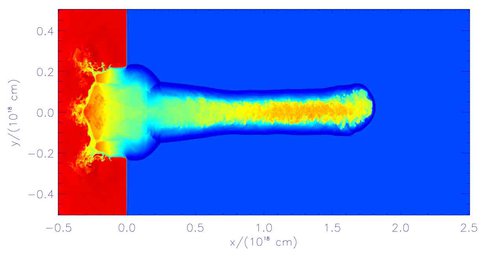2011 Annual Science Report
 Arizona State University
Reporting | SEP 2010 – AUG 2011
Arizona State University
Reporting | SEP 2010 – AUG 2011
Astrophysical Controls on the Elements of Life, Task 3: Model the Injection of Supernova Material Into Star-Forming Molecular Clouds
Project Summary
Our Solar System is known to have contained short-lived radionuclides such as 26Al and 60Fe when it formed. These must have been created either during or just before Solar System formation. A supernova explosion is thought to be the most likely source. Depending on the manner of supernova injection, other elements relevant to life may accompany the radionuclides. In this task we study how a supernova might inject material into the molecular cloud from which the Solar System formed, before formation of the protostar. This tests the hypothesis of supernova injection and quantifies its contributions to radionuclides and other elements.
Project Progress
We have made significant progress toward the first calculations of the injection of supernova material into its nearby natal molecular cloud. Under the supervision of Evan Scannapieco and Steve Desch, NAI-funded postdoc Liubin Pan has carried out a suite of numerical simulations of how clumpy supernova ejecta can penetrate into molecular clouds. Our results indicate that all stars forming late in the evolution of a high-mass star-forming region are likely to be contaminated by ~ 10-4 Msol of supernova material. This potentially fully explains the existence of short-lived radionuclides in meteorites at their observed abundances. This work is in preparation for publication in the Astrophysical Journal (Pan et al. 2012). Desch will present this work at the Workshop on the First Solids in the Solar System, in Kauai, in November 2011.
Penetration of a bullet of supernova material into a molecular cloud. The 10^-4 solar mass bullet, 10^16 cm in diameter, enters from the left at 2000 km/s, having traveled from the supernova, through low-density ionized gas (red), to the dense molecular cloud (blue). The supernova material (yellow) fills the cavity carved out by the bullet. Some escapes the cloud but most is trapped within it and will be incorporated in new solar systems forming from the cloud.”
Publications
-
Ellinger, C. I., Young, P. A., & Desch, S. J. (2010). COLLATERAL EFFECTS ON SOLAR NEBULA OXYGEN ISOTOPES DUE TO INJECTION OF 26 Al BY A NEARBY SUPERNOVA. The Astrophysical Journal, 725(2), 1495–1506. doi:10.1088/0004-637x/725/2/1495
-
PROJECT INVESTIGATORS:
-
PROJECT MEMBERS:
Evan Scannapieco
Collaborator
Patrick Young
Collaborator
Liubin Pan
Postdoc
-
RELATED OBJECTIVES:
Objective 1.1
Formation and evolution of habitable planets.
Objective 3.1
Sources of prebiotic materials and catalysts

